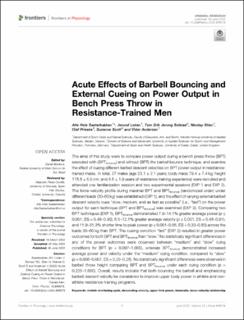| dc.contributor.author | Sæterbakken, Atle Hole | |
| dc.contributor.author | Løken, Jørund | |
| dc.contributor.author | Solstad, Tom Erik Jorung | |
| dc.contributor.author | Stien, Nicolay | |
| dc.contributor.author | Prieske, Olaf | |
| dc.contributor.author | Scott, Suzanne | |
| dc.contributor.author | Andersen, Vidar | |
| dc.date.accessioned | 2023-02-16T10:53:19Z | |
| dc.date.available | 2023-02-16T10:53:19Z | |
| dc.date.created | 2022-09-29T11:15:46Z | |
| dc.date.issued | 2022 | |
| dc.identifier.citation | Frontiers in Physiology. 2022, 13 . | en_US |
| dc.identifier.issn | 1664-042X | |
| dc.identifier.uri | https://hdl.handle.net/11250/3051437 | |
| dc.description.abstract | The aims of this study were to compare power output during a bench press throw (BPT) executed with (BPTbounce) and without (BPT) the barbell bounce technique, and examine the effect of cueing different barbell descent velocities on BPT power output in resistance-trained males. In total, 27 males (age 23.1 ± 2.1 years; body mass 79.4 ± 7.4 kg; height 178.8 ± 5.5 cm; and 4.6 ± 1.9 years of resistance training experience) were recruited and attended one familiarization session and two experimental sessions (EXP 1 and EXP 2). The force–velocity profile during maximal BPT and BPTbounce (randomized order) under different loads (30–60 kg) was established (EXP 1), and the effect of varying external barbell descent velocity cues “slow, medium, and as fast as possible” (i.e., “fast”) on the power output for each technique (BPT and BPTbounce) was examined (EXP 2). Comparing two BPT techniques (EXP 1), BPTbounce demonstrated 7.9–14.1% greater average power (p ≤ 0.001, ES = 0.48–0.90), 6.5–12.1% greater average velocity (p ≤ 0.001, ES = 0.48–0.91), and 11.9–31.3% shorter time to peak power (p ≤ 0.001–0.05, ES = 0.33–0.83) across the loads 30–60 kg than BPT. The cueing condition “fast” (EXP 2) resulted in greater power outcomes for both BPT and BPTbounce than “slow.” No statistically significant differences in any of the power outcomes were observed between “medium” and “slow” cuing conditions for BPT (p = 0.097–1.000), whereas BPTbounce demonstrated increased average power and velocity under the “medium” cuing condition, compared to “slow” (p = 0.006–0.007, ES = 0.25–0.28). No statistically significant differences were observed in barbell throw height comparing BPT and BPTbounce under each cuing condition (p = 0.225–1.000). Overall, results indicate that both bouncing the barbell and emphasizing barbell descent velocity be considered to improve upper body power in athlete and non-athlete resistance-training programs. | en_US |
| dc.language.iso | eng | en_US |
| dc.publisher | Frontiers Media S.A. | en_US |
| dc.rights | Navngivelse 4.0 Internasjonal | * |
| dc.rights.uri | http://creativecommons.org/licenses/by/4.0/deed.no | * |
| dc.title | Acute Effects of Barbell Bouncing and External Cueing on Power Output in Bench Press Throw in Resistance-Trained Men | en_US |
| dc.type | Peer reviewed | en_US |
| dc.type | Journal article | en_US |
| dc.description.version | publishedVersion | en_US |
| dc.rights.holder | © 2022 Saeterbakken, Loken, Solstad, Stien, Prieske, Scott and Andersen. | en_US |
| dc.source.pagenumber | 10 | en_US |
| dc.source.volume | 13 | en_US |
| dc.source.journal | Frontiers in Physiology | en_US |
| dc.identifier.doi | 10.3389/fphys.2022.899078 | |
| dc.identifier.cristin | 2056781 | |
| cristin.ispublished | true | |
| cristin.fulltext | original | |
| cristin.qualitycode | 1 | |

